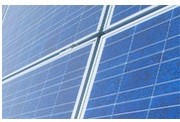Fuel-efficiency and "
greener" vehicles might be the trend in autos, but the technology is showing up in more than just the SUVs at Mercedes-Benz U.S. International.
It also is being installed in the sprawling auto plant's buildings.
The Vance plant recently installed
solar panels on the roof of its Visitor Center and the adjoining Bill Taylor Institute that will be used to heat the building's water.
"We are doing the finishing tie-ins now, and it should be online about the first of the year," said Phil Onstott, assistant manager of Mercedes' facility engineering department.
Onstott said the new water heater employs a
hybrid technology that will use solar power to heat water but also have the ability to switch to natural gas when more hot water is needed.
Mercedes does not disclose the costs of such investments, but Onstott said it hopes to save money on its water heating. The solar-natural gas water heating will be monitored closely by computers, and "if it works out, we could put more in the plant," he said.
The project started when Alagasco approached Mercedes to see if it would be interested in trying the new solar-natural gas water heating technology, said Onstott, a 15-year Mercedes employee who describes his department as "the MBUSI engineers who have nothing to do with auto production."
The new water heating system will be similar to conventional water heaters in which cooler water flows into a tank and is heated by natural gas power flame or electricity. With the new system, the water will be warmed by the heat generated from the solar panels. If it is nighttime, too cloudy or more hot water is needed, the natural gas burners will kick in to assure a steady supply of warm water, Onstott said.
In that way, the system is similar to the hybrid sport utility vehicles being made in Vance. The vehicles run on electrically charged batteries but can switch automatically to gasoline or diesel when extra power is needed.
The solar water heating is just one of the "
green" technologies being embraced at MBUSI.
Early in 2011, the company also will install solar- and wind-powered collectors on top of two light poles at its Plant 1 entrance. The power generated by the solar and wind collectors will be stored in batteries in the base of the poles and will power the poles' hybrid LED roadway lights.
The poles will not be wired into an electrical grid like most street lights, Onstott said, and will rely on just the
sun and wind. One battery charge will be sufficient to power a light for three nights, he said.
The wind turbine will have cylinders to collect wind power and will not have the windmill-like propellers traditionally seen on wind-powered projects. The cylinder collectors, unlike the propellers, will make the project bird-friendly, Onstott said.
The wind power will light the road lights night and day and will operate quietly, he said.
"Both projects are production trials in a way," Onstott said. "They are our way of checking out various energy-efficiency technologies as we consider options that may be useful for the rest of our operations."
In a third "green" project, MBUSI plans to replace the high-intensity discharge lighting in its production plant with high-efficiency flow lighting next year.
That work will start in January and will be done in phases so as not to disrupt production. Onstott said when the new lighting is completely installed, the plant should save about 12,000 megawatts of electricity yearly.
Production workers also will notice the difference with the new lighting being a little brighter, he said.
All the efforts are ways to continue reduction of MBUSI's carbon footprint, he said. This past spring, the company reached a milestone when its internal recycling efforts resulted in zero waste going to landfills, he said.
"Everything from the plant either gets reused or recycled now."
Read full article
make your own solar panels
Join The Green Club

 Share
Share














